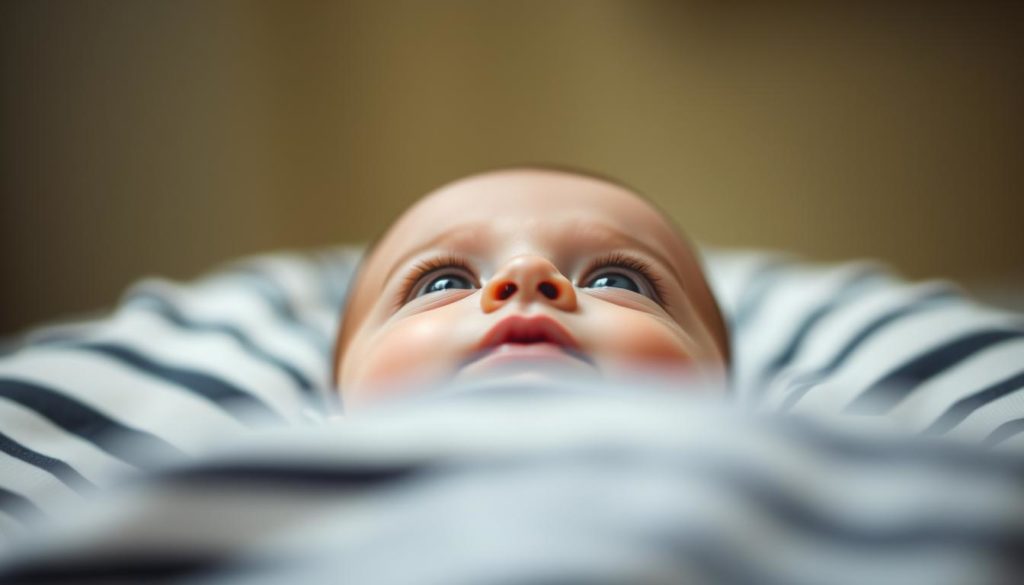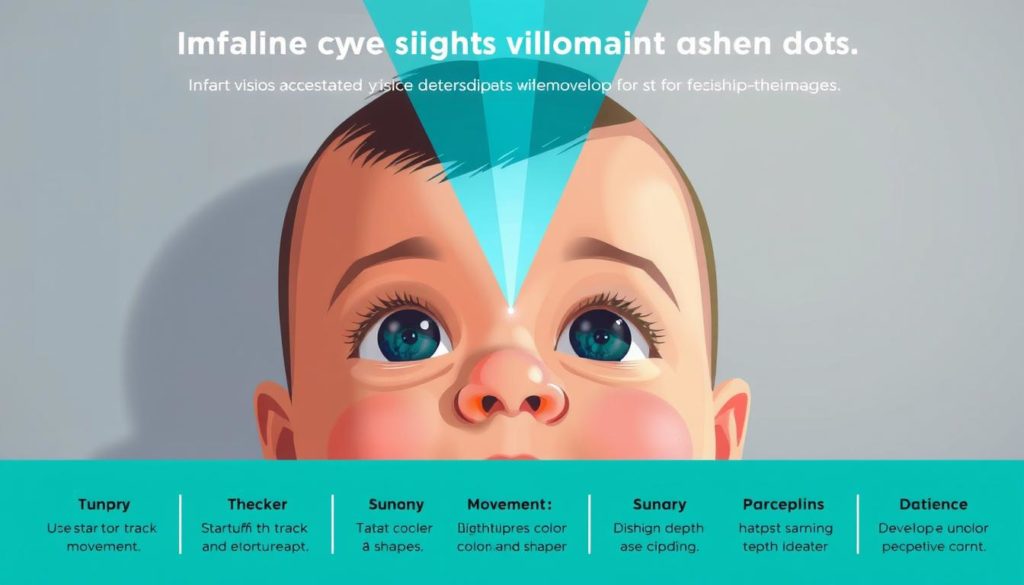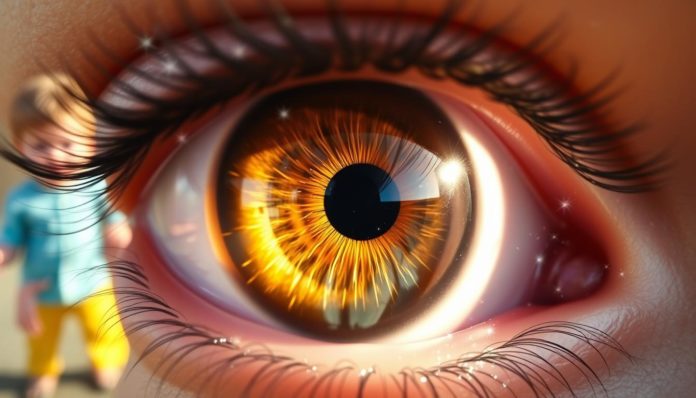Did you know by 6 months, an infant’s vision is just 20/100? This means they see clearly only 20 inches away. Their visual skills start developing from birth and keep growing into adulthood. Newborns have to learn how to focus their eyes and use them together—a skill as crucial as learning to walk or talk.
It’s important to understand when babies should reach vision milestones. Spotting any eye problems early can prevent delays in development. That’s why the first eye exam is key at around 6 months. Programs like InfantSEE play a big role in making sure infants get the eye care they need. Regular check-ups and early help are critical.
Parents are crucial in helping their child’s vision grow. Activities that are right for their age can really boost visual skills. These activities start simple and get more advanced, like learning to judge distances. By watching their eye health and developmental progress, parents can help build a foundation for strong vision in their child’s life.
Understanding Eye Growth in Newborns
Learning how newborn vision changes is key to helping babies’ eyes develop well. At first, their eyes can sense light and see things to the side, but things look blurry and far away objects are hard to see.
Newborn Eye Size and Light Sensitivity
In their first weeks, newborns’ eyes can’t handle bright light well because they have tiny pupils. This is nature’s way of shielding their sensitive eyes. But soon, they begin to tell apart light from dark. This is the start of big changes in how they see. As their pupils get bigger, their eyes can pick up more details, letting them see things close to them clearer.

Peripheral Vision Development
Newborns might not see clearly right away, but they can see things off to the side. This side vision is a bit unclear at first but gets better quickly. By the time they are one month old, babies start to focus on faces for short periods. They also like bright colors. This happens within three feet of them. These vision developments are big steps for babies, helping them to begin recognizing big shapes and bold colors.
Let’s explore the stages of vision growth:
| Age Range | Vision Characteristics |
|---|---|
| 0-1 Month | Light sensitivity, developing focus on objects |
| 1-3 Months | Increased peripheral vision, preference for bright colors |
| 3-4 Months | Improvement in recognizing faces and moving objects |
Milestones of Infant Vision Development
Watching an infant’s vision develop is truly amazing. Each step from birth up to their first year is key. It helps improve their sight and how they coordinate their movements.
Birth to 4 Months: Visual Stimulation
In the first few months, it’s important to help babies’ eyes grow. Parents and caregivers can do this by helping them follow objects with their gaze. Babies love looking at things that are black and white or really bright. This makes their vision better.

5 to 8 Months: Depth Perception and Crawling
From 5 to 8 months, babies start understanding how far away things are. This is when they usually begin to crawl. Being able to see in 3D helps them move around and explore.
9 to 12 Months: Grasping and Coordination
By 9 to 12 months, grabbing objects gets much easier for babies. They use their thumbs and first fingers. This doesn’t just help with understanding distance. It also improves how they move and remember what they see.
| Age Range | Key Milestones |
|---|---|
| Birth to 4 Months | Visual Stimulation, Eye-Hand Coordination |
| 5 to 8 Months | Depth Perception, Crawling |
| 9 to 12 Months | Grasping, Enhanced Coordination |
Indicators of Eye and Vision Problems in Infants
Finding vision problems early in infants is key for good eye development. Knowing the eye health red flags helps parents act fast.
Signs to Watch For
Spotting eye health issues early can prevent serious problems later. Parents should look out for:
- Excessive tearing: This could mean the tear ducts are blocked.
- Red or encrusted eyelids: This can show there’s an infection.
- Constant eye turning: This might point to a muscle issue.
- Extreme sensitivity to light: This could signal high eye pressure.
- Appearance of a white pupil: This could be eye cancer or other major problems.
When to See a Doctor
If you see any of these signs, getting a pediatric eye exam is crucial. It’s usually advised to have the first exam at 6 months old. This checks the baby’s vision strength, eye alignment, and overall health. Quick action by an eye doctor can make a big difference in care and outcomes.
Role of Parents in Vision Development
Parents are vital to their child’s eye health and visual growth. They help build a strong vision from the start by getting involved early. By being part of your child’s visual world, you can help them see and understand their surroundings better.
Age-Appropriate Activities for Visual Development
It’s important to do activities that fit your child’s age and growth stage.
- Birth to 4 months: Use soft lights, change the crib’s spot often, or offer toys that they can reach and touch. This helps their visual skills.
- 5 to 8 months: Play on the floor with them, use toys that hang above the crib, and play back-and-forth games to help their sight and coordination.
- 9 to 12 months: Hide-and-seek, naming objects, and encouraging crawling can boost visual memory and word skills.
By doing these activities, you play a key role in enhancing your child’s vision. Being actively involved keeps their eyes healthy and enriches their ability to see the world.
Eye Growth Age: Myths and Facts
Learning the truth about eye growth myths and vision facts is crucial for good eye health. It’s a myth that babies are born with eyes that don’t change. In fact, eyes grow a lot in the first few years.
Many believe that only old age causes our eyesight to worsen. But it’s not just age. Genetics, what we eat, how we live, and sun exposure play roles too. Knowing these facts helps us take better care of our eyes.
Let’s clear up some things with a few comparisons:
| Myths | Facts |
|---|---|
| Babies have fully developed eyes at birth. | Babies’ eyes grow and develop significantly after birth. |
| Eyesight declines due to aging alone. | Eyesight can be affected by genetics, diet, lifestyle, and UV exposure. |
Understanding the truth about our eyes helps us see the whole picture of vision development. It’s important to leave behind the myths. We should rely on what we know to be true to keep our eyes healthy at every age.
Visual Changes During Childhood
Kids’ eyesight gets much better as they move from babies to little kids. This time is very important because it helps set up their eyesight for later on. Knowing what changes happen can help grown-ups make sure kids’ eyes grow the best way they can.
Eye Changes from Ages 1 to 2
From age 1 to 2, kids get better at using their eyes and hands together. They also get better at judging distances. They start to know familiar things and pictures, which helps their eyes get better. Kids this age love to explore, so it’s a key time to help their eyesight develop well.
Monitoring Eye Health During Early Childhood
Keeping an eye on eye health is super important when kids are little. Parents can help a lot by watching how their kids interact with stuff around them. They should also make sure their kids see an eye doctor regularly. Catching and fixing eye problems early can make a big difference in how kids see the world as they grow.
| Age Range | Visual Milestones | Recommended Actions |
|---|---|---|
| 1 to 2 Years | Improved depth perception, recognition of familiar objects and pictures | Encourage eye-hand coordination activities, ensure regular eye checkups |
| 2 to 5 Years | Further development of visual acuity, ability to focus on close objects | Monitor for signs of vision issues, provide stimuli for visual development |
Understanding Changes in Vision During Adolescence
Adolescence is key for vision changes. Understanding these alterations helps protect teen eye health.
Growth Spurts and Eye Size
Eye growth spurts are common during adolescence. The eyes expand to about 24 millimeters by the early twenties. This size is similar to a peanut. Such growth can lead to vision changes, including common conditions like myopia or hyperopia.
Common Vision Problems in Teens
As eyes grow, it’s vital to watch teen eye health. Myopia might make it hard for teens to see far objects. On the other hand, hyperopia can cause issues focusing on things up close. Spotting early signs, like frequent squinting or headaches when reading, aids in timely help.
Maintaining Good Eye Health into Adulthood
As we get older, keeping our eyes healthy becomes more important. It’s crucial to go for regular eye exams. These help find early signs of eye problems like glaucoma or macular degeneration early.
To protect your eyes, it’s important to block UV light. Wear sunglasses that stop 100% of UVA and UVB rays. This shields your eyes from cataracts and other damage from the sun. Making this a habit helps keep your vision sharp for life.
Eating right helps too. Foods like leafy greens and fish are good for your eyes. Exercising helps as well by boosting blood flow. This is especially good for your retina and helps keep your eyesight strong.
It’s also vital to manage health issues like diabetes and high blood pressure. These can harm your eyes if not controlled. Keeping these conditions in check helps keep your vision clear.
“Maintaining a lifestyle that includes a healthy diet, regular exercise, and protective practices is essential for long-term eye health,” states the American Academy of Ophthalmology.
Here’s a simple eye care checklist:
- Schedule annual eye examinations.
- Wear UV-protection sunglasses.
- Follow a balanced diet rich in leafy greens and fish.
- Engage in regular physical activity.
- Manage chronic conditions such as diabetes and hypertension.
Following the steps above helps cover all bases for adult eye health. This lays a strong groundwork for keeping your vision clear as you age.
How Aging Affects Vision
As we age, our eyes undergo several changes. These changes may lead to vision problems. It’s crucial to know what these changes are and how to handle them.
Common Age-Related Vision Problems
Starting in the early to mid-40s, many people find it hard to see things up close, a condition known as presbyopia. It also gets tougher to see in low light and tell different colors apart.
The eye’s lens becoming denser and less light reaching the retina make seeing in dim light harder. Eye issues like macular degeneration, diabetic retinopathy, cataracts, and glaucoma also become more common. Learn more about aging eyes at aging and your eyes.
Ways to Maintain Eye Health as You Age
To keep your eyes healthy as you get older, taking certain steps is vital. Getting regular eye exams is key. They help catch diseases like macular degeneration and glaucoma early. Plus, living a healthy lifestyle helps a lot.
- Wear sunglasses that block UV light to shield your eyes from the sun’s harmful rays.
- Do eye exercises and rest your eyes regularly, especially if you spend a lot of time on electronic devices.
- Eating a healthy diet that includes leafy greens, fish, and nuts supports your eye health.
Knowing about these measures and actively taking them can help sustain your vision. They can also lessen the chance of big vision problems. For deeper insights on caring for aging eyes, see this guide on eye health with age.
Natural Remedies for Eye Health
It’s crucial to keep your eyes healthy naturally. This prevents vision problems and boosts overall health. Eating right and doing eye exercises are key steps.
Diet and Nutrition
A diet full of vitamins and minerals is vital for eye health. Important nutrients are vitamin A, C, E, and omega-3s. Also, lutein and zeaxanthin found in fruits, veggies, fish, and greens are essential. Experts say eating these foods is the best way to get these nutrients.
Eye Exercises to Improve Vision
Besides a healthy diet, vision exercises are good for your eyes. They range from simple breaks from screen time to focusing drills. Doing these regularly fights eye strain and keeps your eyes healthy.
Eye Care Tips for All Ages
Taking care of your eyes is important at every age. It’s all about daily habits and regular check-ups. Having your eyes checked often can spot issues early, like eye diseases or vision changes. This is key to keeping good eyesight as you get older. Also, wearing the right protection against the sun’s UV rays matters a lot.
Regular Eye Exams
Getting your eyes checked regularly is super important. These exams help find problems early, such as glaucoma, cataracts, or macular degeneration. For kids, they can catch vision issues that might impact school and learning. Adults should get checked at least every two years. Seniors need to go more often to keep an eye on vision as they age.
Protective Measures Against UV Light
UV rays can really damage your eyes if you’re not careful. One easy way to protect them is by wearing sunglasses with 100% UV protection. Also, a wide-brimmed hat can block extra sunlight, helping your eyes. Remember, UV protection isn’t just for summer; it’s a year-round need. Living healthy by not smoking and keeping your blood pressure and diabetes in check is also good for your eyes.
FAQ
What is vision development in infants?
Vision development is a step-by-step process in infants. It starts at birth and keeps going as they grow. It’s about them learning to focus, move their eyes right, and use both eyes together. It’s much like how they learn walking or talking.
How sensitive are newborns’ eyes to light?
Newborns have very light-sensitive eyes with tiny pupils for protection. They can spot light and dark changes and start focusing on things close to them.
What is peripheral vision, and how does it develop in newborns?
Peripheral vision lets us see things to the side when we’re not looking directly at them. For newborns, it’s blurry at first. But it gets clearer as they grow, helping them see big shapes and bright colors.
What visual milestones do infants achieve from birth to 4 months?
From birth to 4 months, babies really start seeing the world. They can follow moving things with their eyes. They also start reaching out for what they see, connecting sight and touch.
When do infants start developing depth perception?
Babies develop depth perception around 5 to 8 months old. Their eyes start to work together. Moving around helps them get better at judging distances.
What are the significant vision developments at 9 to 12 months?
Between 9 and 12 months, babies get better at remembering what they see and moving smoothly. They learn to grab things precisely and judge how far away stuff is.
What are some signs of eye and vision problems in infants?
Watch out if babies tear up a lot, have red or crusty eyelids, turn their eyes too much, can’t handle bright light, or have a white spot in the pupil. These signs mean it’s time for a doctor’s visit.
When should infants have their first eye exam?
It’s good for babies to have their eyes checked at about 6 months old. This way, doctors can check if they see clearly, if their eyes are working together, and if their eyes are healthy.
How can parents support their child’s vision development?
Parents can help with things like using soft lights, moving the crib around, and giving babies interesting toys to look at. Playing on the floor, hiding and seeking, and talking about what they see can also boost their learning.
Are babies born with fully developed eyes?
No, babies’ eyes aren’t fully grown when they’re born. They develop and get better at seeing as they grow.
What visual changes occur from ages 1 to 2 years?
Between 1 and 2 years, kids get really good at using their eyes and hands together. They start to know familiar things and get curious about everything around them.
What should parents monitor regarding childhood eye health?
Parents should watch how their kids look at the world around them. It’s important to keep up with eye doctor visits to spot any problems early on.
How does adolescence affect eye growth and vision?
When kids hit their teens, their eyes get bigger. This can lead to common eye troubles like nearsightedness or farsightedness. Growth spurts can affect their vision too.
What are common vision problems in teens?
Teens often struggle with seeing things up close, getting nearsighted, or having trouble seeing far away. These are pretty typical issues.
How can adults maintain good eye health?
Adults should get their eyes checked regularly. They need to guard against sunlight, eat healthily, stay active, and manage any chronic conditions like diabetes or high blood pressure.
What are some common age-related vision problems?
As people get older, they might have trouble seeing up close, noticing changes in light, or seeing colors well. Problems like macular degeneration, diabetic eye disease, and cataracts can also start to show up.
What natural remedies support eye health?
Eating foods full of vitamins, like fish and leafy greens, helps avoid eye problems as we age. Doing eye exercises can also keep our eyes in good shape.
What are essential eye care tips for all ages?
Getting regular eye checks, shielding eyes from the sun, and avoiding smoking are key. Also, taking care of blood pressure and diabetes, and being safe during activities can prevent eye injuries.


